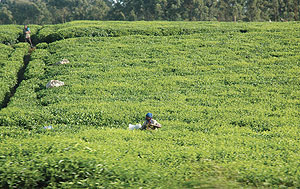Prices of Rwanda’s teas sold through the weekly Mombasa auction market rose significantly by 29.8 percent last week in response to high quality supplies, according to Ocir-Thé. The agency that regulates tea activities in the country said that Rwanda’s teas attracted an average price of $4 (Rwf2,279) per kilogram last week compared to $3.08 (Rwf1755) in the previous week.


Prices of Rwanda’s teas sold through the weekly Mombasa auction market rose significantly by 29.8 percent last week in response to high quality supplies, according to Ocir-Thé.
The agency that regulates tea activities in the country said that Rwanda’s teas attracted an average price of $4 (Rwf2,279) per kilogram last week compared to $3.08 (Rwf1755) in the previous week.
This is the highest average price generated by the product in the month of November which saw prices fluctuate between $2.5 (Rwf1,245) and $3.5 (Rwf1,995).
"The increase in prices is due to the high quality of the Rwandan tea that is offered on the market,” said Shyaka Hermenegilde, Head of Administration and Human Resource Department at Ocir-thé.
However, farm gate prices have remained unchanged at Rwf86 per kilogramme of green leaf tea. But Ocir-Thé said that negotiations are ongoing between stakeholders to increase farm gate prices slightly higher than the current value per kilogramme.
This upward trend came as surprise since it was expected that the prices would take a dip given the huge quantity of supplies at Mombasa during this period.
In an earlier interview with Shyaka, he predicted that prices will dwindle due to high supply of green leaf propelled by the rainy season.
The quantity supplied last week also increased to 99,721 kilograms compared to 68,448 kilograms that was supplied previously.
Shyaka said Rwanda’s tea supplies at the auction market would continue to rise up to March next year since it is a rainy season.
With the favourable rains coupled with the application of fertilizers, the authority anticipates higher production.
On the international market, tea prices have been rising slightly because of a fall in production following unfavourable weather conditions in India while the demand for the commodity in Europe remains strong.
Ends


